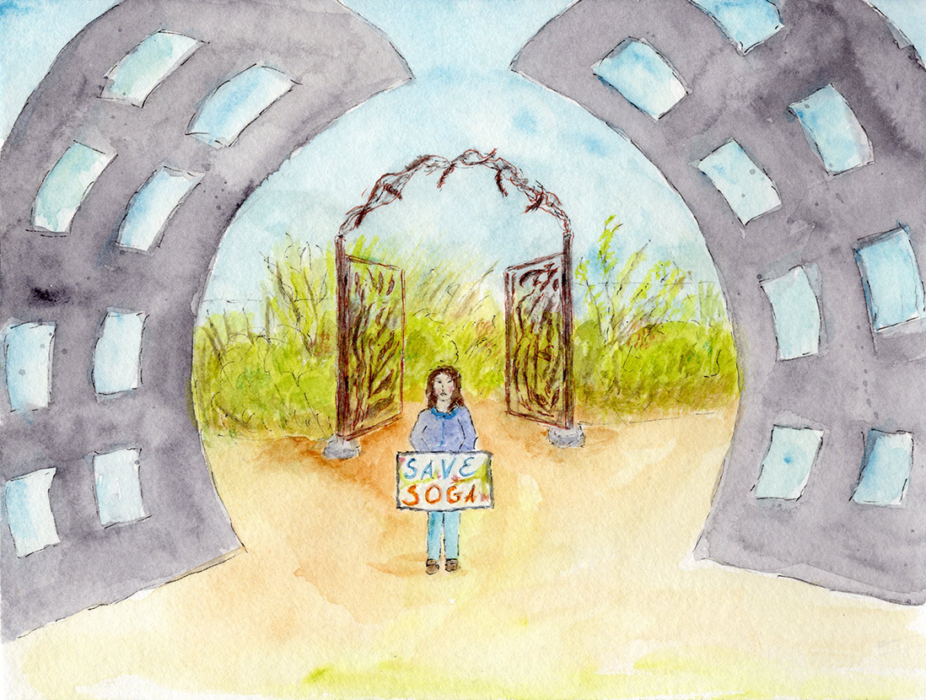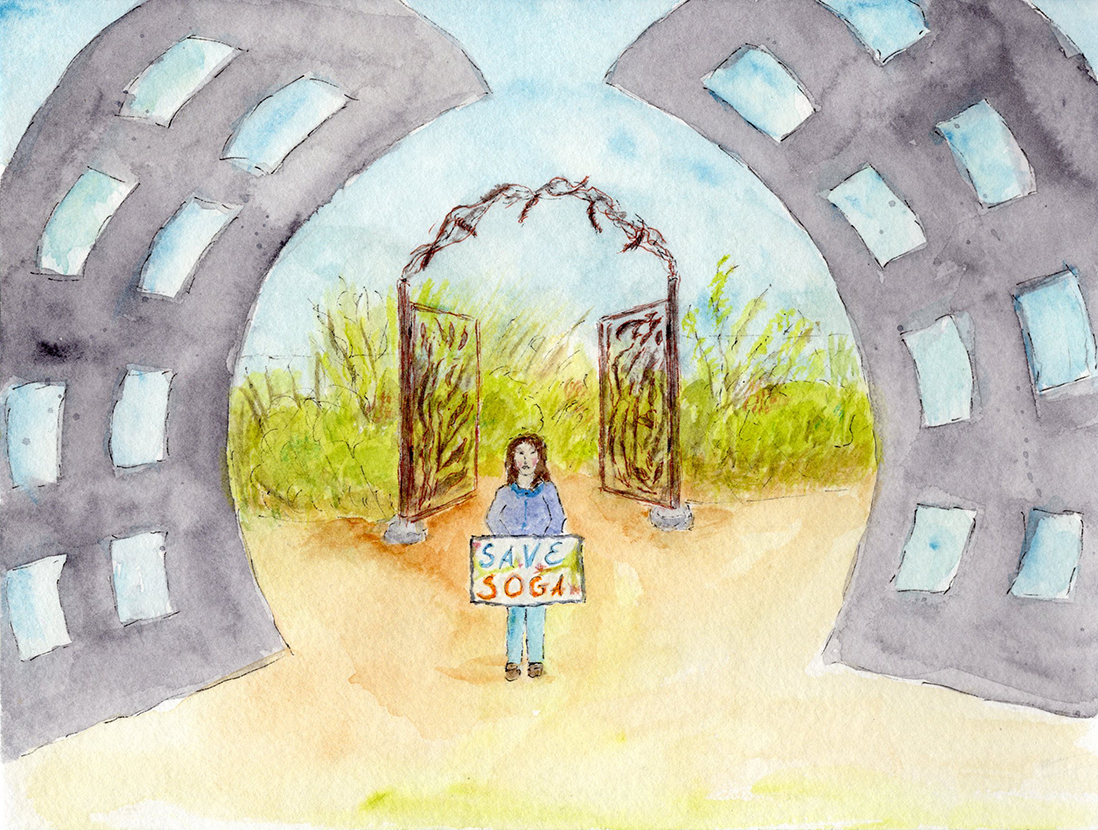
Most mornings, Coleman Rainey tends to a farm in the middle of a city. The Oxford Tract, owned by the University of California, Berkeley on the edge of a burgeoning downtown, contains greenhouses, laboratories, and a no-till farm where Rainey and student volunteers grow tomatoes, peppers, broccoli, fruits, leafy greens, and squash. They also tend marigolds and other flowers to attract pollinators. The farm is used by 40 different research teams on campus, from plant biologists to ecologists, and some 2,000 people use the nearby garden run by the Student Organic Gardening Association each year.
Rainey, a graduate student researching soil health, sees the open field as more than a space for science. “My vision for urban agriculture is that it’s so much more than just growing food,” he said. “It’s about reconnecting people to the earth and restoring the intricate web of humans, non-humans, and the natural cycles of this place.”
That’s why a recent announcement from UC Berkeley Chancellor Carol Christ cut particularly deep. Sometime in the next four years, the Oxford Tract, at least a large part of it, will be developed for student housing.
Christ announced the move in April, after years of task forces and reports detailed the campus’s growing housing crisis. Ten percent of UC Berkeley students reported experiencing some form of homelessness, according to a 2017 survey. Another report found that developing the Oxford Tract could provide anywhere from 1,000 to 3,000 beds — a significant portion of the university’s goal to nearly double the amount of beds on campus in the next decade.
While admitting that the campus needs more housing, some students and faculty say that developing the Oxford Tract would disrupt grant-funded research and contradicts the university’s land-grant mission. Some are concerned that the new housing won’t even be affordable, while others say there are better spots for housing, such as the 2.5-acre gardens next to the chancellor’s estate.
But according to Rainey, this campus squabble points to a deeper issue, one in which urban agriculture is pitted against the housing crisis in the Bay Area and across the West. “This is a continuation of manifest destiny,” he said, noting the historical ethos where land is seen as transactional, and where agroecology — a system of growing food that prioritizes ecosystem health and food sovereignty — contends with private land ownership. “I am not against building housing on the Oxford Tract,” Rainey said. “But what kind of housing? And on whose terms?”
In the last 30 years, the footprint of urban farms has grown by more than 30 percent in the United States, and with that growth has come the discovery of its benefits to both public health and climate change mitigation. “I believe that raising fresh fruits, vegetables and some animal products near consumers in urban areas can improve local food security and nutrition, especially for underserved communities,” UC Berkeley professor Miguel Altieri wrote in The Conversation in February. Altieri also noted that urban agriculture can make drastic cuts to the enormous amount of greenhouse gases emitted as trucks haul millions of tons of food into urban areas each day.
Those benefits have been realized at the Oxford Tract. Last year, more than 2,700 pounds of produce grown there went to the city’s food pantries to address campus food insecurity, which is a prominent issue. The University of California system’s Global Food Initiative found that 44 percent of undergraduate students and 26 percent of graduate students in the statewide UC system reported experiencing food insecurity.
But urban agriculture has its barriers. “The biggest challenge is access to land,” wrote Altieri. “In the Bay Area and elsewhere, most obstacles to scaling up urban agriculture are political, not technical.”
In California, 79 percent of urban farmers do not own the property they cultivate, according to UC Berkeley researchers. Local governments have tried to encourage farming through “urban agriculture incentive zones” and other tax breaks for landowners, but these policies still leave urban farms vulnerable to the gears and pulleys of the Bay Area’s fluctuating real estate market.
For instance, in 2009, then-Mayor Gavin Newsom drafted a “green development agreement” that allowed San Francisco landowners to lock in their right to build if they leased their land to agricultural or environmental projects. This agreement allowed projects like the Hayes Valley Farm, a permaculture food forest and community gathering space that saw 20,000 volunteers during its three-year stint, to take root.
Newsom’s plan was adopted during an economic slump, but in 2013, once the economy rebounded, the Hayes Valley farmers vacated the premises, as expected. Condominiums shot up on the land within two years; affordable housing is next on the docket.
Such farms are seen by some as barriers to the real need for housing. In an article in The Atlantic titled “How Urban Farming Is Making San Francisco’s Housing Crisis Worse,” Conor Friedersdorf wrote in 2014 that urban ag tax credits make “the city’s wealthy property owners better off” while disincentivizing new construction that would benefit “all income groups who’d like to live here.” He called subsidized urban farming in the midst of a housing crisis “insanity.”
There are ways to simultaneously combat food and housing insecurity. For instance, the Tenderloin Neighborhood Development Corporation, a nonprofit housing developer, integrates rooftop and courtyard gardens into its developments. “While it is housing, it can still be a great place for the greening of our city and having people be connected to our food and where it comes from,” said Katie Ettman, a food policy expert at the San Francisco Bay Area Planning and Urban Research Association.
And getting that balance right is important. In 2014, Alana Siegner, a food systems researcher at UC Berkeley, co-founded a team called Tiny House in my Backyard, or THIMBY, to design sustainable housing that could coexist with urban agriculture projects. She also said planners could consider so-called “agrihoods,” a kind of housing development that features an edible garden where you might expect a courtyard pool or yard to be.
“The housing crisis and food insecurity are interlinked,” Siegner said. “If we address one problem without the other, we’re just going to be making the other worse.”
At the Oxford Tract, many are concerned such a balance won’t be struck, even though Christ has promised that development would not replace a quarter-acre student garden adjacent to the open farm. “The housing crisis can’t be a justification for developing on agricultural spaces that give students access to affordable fresh produce,” student Kajol Gupta wrote in a recent op-ed in the school paper, The Daily Californian.
Further complicating Oxford Tract’s development is the fact that it is ag land on a land-grant university committed to agricultural research. “The work that’s done in the field is more translatable to real-world application,” said Heidi Wipf, a Ph.D. candidate in plant biology.
According to the letter from Christ, greenhouses and labs may be incorporated into the new development. “We recognize the importance of core research facilities in close proximity to campus and view this project as an opportunity to develop more modern and energy efficient facilities,” she wrote.
But losing the open field space remains inevitable. “Addressing the student housing crisis necessitates building on every parcel of university-owned property in close proximity to the campus,” a spokesperson from the Chancellor’s office said in an email.
Once construction starts, student farmers will be expected to relocate to another campus-owned site called the Gill Tract. For Rainey, being asked to relocate from one plot of land to another sits at the core of the issue. Rainey explained how the soil at Oxford Tract has become increasingly productive with decades of agricultural activity, which is just one aspect of the land that’s difficult to put a value on.
“They say, ‘You can exchange this soil for other soil.’ But that’s paving over the view that there’s a nested set of relationships here that are inextricable from where they’re formed,” said Rainey. “When they look at this land, they don’t see what we see.”

